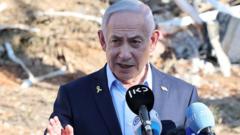In the wake of heavy casualties and ongoing hostilities, the potential for a ceasefire agreement between Israel and Hamas takes center stage as Prime Minister Netanyahu engages with President Trump, amidst calls for complete peace from both sides.
**Hope for Ceasefire in Gaza as Netanyahu Meets Trump Amid Ongoing Conflict**

**Hope for Ceasefire in Gaza as Netanyahu Meets Trump Amid Ongoing Conflict**
Growing optimism emerges for a Gaza ceasefire as tensions between Israel and Hamas escalate, coinciding with Israeli PM Netanyahu's U.S. visit.
After 21 months engulfed in conflict, the prospect of a ceasefire in Gaza seems closer as Israeli Prime Minister Benjamin Netanyahu arrives in Washington for discussions with U.S. President Donald Trump. The two leaders began their meeting with hopes of solidifying a temporary truce and advancing negotiations on a 60-day ceasefire agreement, which includes hostage exchanges and humanitarian aid provisions. "We are working to achieve the deal that has been discussed, under the conditions we have agreed," said Netanyahu, underscoring his expectations for fruitful dialogue.
Trump had previously emphasized his commitment to pressuring Israel to end its military actions in Gaza, suggesting that he believes a deal is imminent. Meanwhile, indirect negotiations continue in Qatar amid increasing death tolls reported in Gaza due to Israeli airstrikes. While many Palestinians express trepidation towards a transient ceasefire, fearing a return to violence after 60 days, families of hostages remain hopeful for the safe return of their loved ones.
Demonstrations in Israel have spotlighted public sentiment demanding government action to secure the release of hostages held by Hamas—many of whom are believed to be alive. The ongoing conflict has fostered a sense of urgency to address humanitarian issues in Gaza, where conditions are dire, with many displaced families suffering from lack of basic necessities such as food and water.
Netanyahu's visit marks his third trip to the White House since President Trump assumed office nearly six months ago, and the meeting is occurring in a context where Israeli airstrikes on Iranian sites have seemingly bolstered Netanyahu's standing domestically, despite a fractious coalition government with far-right factions who favor a military resolution over negotiations.
Trump's strategic focus lies beyond the Israel-Palestine conflict, as he is looking to reposition U.S. interests concerning Israel's neighbors and bolster diplomatic efforts in normalizing relations with countries such as Saudi Arabia. Nonetheless, the lengthy conversations between Israel and Hamas regarding the terms of a ceasefire have remained entangled in conflicting demands—Israel seeks temporary cessation in exchange for hostages, while Hamas insists on a full end to military actions in Gaza.
Despite the challenges, a structured agreement has been proposed: Hamas potentially releasing hostages in stages, along with humanitarian support entering Gaza. Tensions remain high, and while opportunities for a deal unfold, skepticism persists among both Palestinians and Israelis, who are wary of promises unfulfilled, especially when considering the heavy toll the conflict has exacted on human lives.
Efforts for peace come amid ongoing criticism of the war’s management and emerging political discord in Israel, with growing calls for a ceasefire as casualties mount. Many express the need for immediate humanitarian relief, as Gaza struggles with alarming shortages of foundational supplies and medical care.
The future remains uncertain as the key players deliberate on the potential paths towards peace in the afflicted region, with both humanitarian consequences and the fate of hostages hanging in the balance.




















